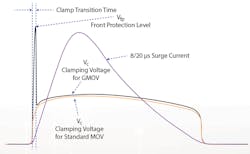To ensure reliability and safety for devices that run on ac and dc power lines, circuit protection is a definite design requirement. Unfortunately, there’s no universal protection solution. Varying levels of exposure to lightning and switching transients, poor line voltage regulation in rural and developing areas, and inconsistency among different grids make a common solution impossible. And, higher-density, higher-performance designs add to the challenge in addressing all circuit-protection device needs. While the UL 1449 standard for surge protective devices (SPDs) outlines the requirements for certification, this too doesn’t provide the basis for a single circuit-protection solution.
This article evaluates standard metal-oxide-varistor (MOV) device performance and documented failure modes in a variety of overvoltage conditions. It presents the types of circuit-protection technologies required to overcome MOV degradation and failure issues.
Existing Overvoltage Protection
Designers of power supplies, power systems, line voltage, telecom systems, and white goods have long used MOVs to guard applications from overvoltage transients such as lightning, power contact, and power induction. As a radial leaded varistor device that provides bidirectional protection, MOVs are popular due to their high current handling, high current absorption, and fast reaction times.
A downside to using MOVs is that they’re known to degrade and possibly fail over time. As the MOV ages, the maximum continuous operating voltage it can withstand will decrease. A MOV exposed to long-term overvoltage surges or high temperatures can go into a failure mode that starts with excessive leakage current, which leads to power dissipation, and eventually can cause application damage due to watt loss heating.
That’s why UL requires testing to safeguard designs against these harmful failure modes. Engineers have learned certain applications that are subjected to voltage transients require more protection than a MOV alone can provide.
Band-Aid Solutions
Designers also commonly employ thermally protected MOVs such as TMOVs (TMOV is a registered trademark of Littelfuse Inc.) for ac power protection. This type of MOV has a thermal fuse that disconnects the MOV from the power source when it reaches an elevated, but safe, temperature.
However, they don’t prevent the leakage current that drives the power dissipation in the off-state; it simply functions to stop a very dangerous failure mode. Most thermally protected MOV fuses are only tested to 10 A in the UL 1449 limited current abnormal overvoltage test. They may not have the ability to open an actual ac line capable of delivering over 100 A.
An important function to consider is that when a thermally protected MOV disconnects itself from the power line, it’s no longer protecting the equipment. While some feature an indicating lead that can be used to sense a line disconnect, this added circuitry increases the protection scheme cost but doesn’t actually increase the device’s overall protection.
To lower the chances of a “thermal event,” some designers choose to select an MOV with a voltage rating far above the application’s normal operating voltage. This approach does reduce the stress and slows a MOV’s aging process, but its higher voltage rating also means the clamping voltage of the MOV will also be much higher. This may force the designer to select higher-voltage-rated (and more expensive) products downstream as they must be rated to survive the higher voltages let through during a surge event.
Achieving Enhanced Protection
Since standard MOVs alone, TMOVs, and higher-voltage-rated MOVs have their limitations for many applications, a different circuit protection approach is needed. One viable solution combines a MOV and a gas discharge tube (GDT) into a hybrid component. Providing a space-saving circuit protection device, the two technologies can be packaged in a familiar MOV radial package, thus providing a drop-in replacement option (Fig. 1).
1. Bourns combines its space-saving GDT, which leverages the company’s FLAT technology, with a MOV, creating a compact, enhanced overvoltage protector that’s a drop-in replacement for standard 14- and 20-mm MOVs.
Putting a MOV and a GDT together offers lower leakage over the life of the MOV, resulting in a predictable failure mode and eliminating harmful watt loss heating. With this approach, the line voltage appears largely across the extremely low-leakage GDT under normal operating conditions. This essentially disconnects the MOV from the ac line and protects it from small transients that pose no threat to the protected equipment that would otherwise only serve to age the MOV.
During a surge event, the GDT quickly (in less than a microsecond) switches on and connects the MOV across the line to clamp the surge voltage to acceptable levels. Once the surge event passes, the line voltage falls across the MOV, switching off the GDT. Once the GDT is off, it in-turn disconnects the MOV from the line as before. The symbiotic functionality of the GDT and MOV working together delivers a longer application life with a higher level of reliability. See how the protection characteristics of a GMOV component are defined in Figure 2.
2. The protection characteristics of the GMOV component are defined by Front Level Protection (Vfp) and Clamping Voltage Level (Vc), where Vfp is measured as 10% of peak current in accordance with IEC 61051-1. Note that Vfp is a very short event, lasting less than 0.3 µs, and represents the time it takes for the GDT to turn on. Vc is the GMOV components’ clamping voltage level, which is the total of the MOV clamping voltage and the on-state arc voltage of the GDT. Vc occurs after the GMOV component has transitioned into its full on-state.
Combining a GDT with a MOV doesn’t impact signal or system operation. The low capacitance of the GDT assures that the hybrid overvoltage protector will not interfere with high-speed data run over ac or dc power lines. Plus, there’s no longer a need to include indicating circuitry and its added costs because the combined MOV and GDT device doesn’t have a thermal fuse.
UL 1449 Certification
The UL 1449 lost neutral test demonstrates the value of taking a hybrid approach—adding a properly selected GDT to the design provides improved performance in lost neutral testing. For example, choosing a UL 1449 listed overvoltage protector saves time and cost for both the design and certification phases of product development, eliminating the guesswork in finding the right combination of discrete parts. Because the Bourns GMOV device is UL listed as a Type 5 SPD, as is a MOV, it offers an alternative that requires minimal requalification.
Advantages from Reduced Leakage Current
Exposure to line irregularities over time and from multiple surges can reduce circuit-protection effectiveness. Leakage current associated with some protection schemes can’t be tolerated by certain applications. Using a new hybrid MOV and GDT overvoltage protection solution such as the Bourns GMOV device delivers the lower leakage current and reduced capacitance that solves these issues.
Energy Star applications also benefit from reduced leakage current, specifically under voltage stress conditions. The reduced leakage current and constant capacitance level advantages offered by a combined MOV and GDT device enable power-line communications to operate reliably at higher data rates.
Protecting Next-Generation Designs
With power systems increasingly exposed to a variety of transient events, discrete MOV technology becomes more susceptible to premature failure and thus negatively impacts equipment reliability. New overvoltage protection that overcomes these issues is now possible. Pairing MOVs and GDTs leverages the best attributes of both protection technologies, offering zero standby energy consumption and no degradation from watt-loss heating. Such a solution extends the life of the MOV while making the system more reliable and safer in the process.
Kurt Wattelet is the Overvoltage Component and SPD Product Line Manager at Bourns Inc.



